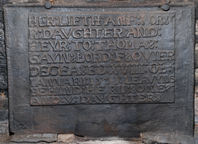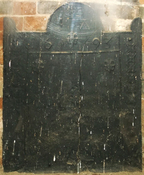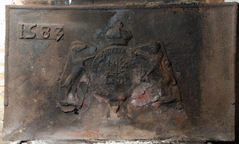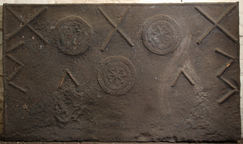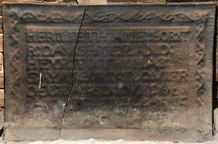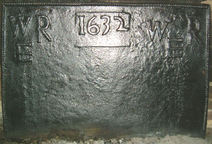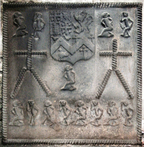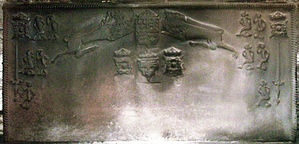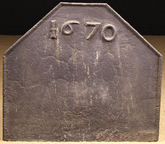-
899
Description: Rectangular; twisted rope edging; top centre, inscription panel.
Notes: The inscription panel is identical to that on the memorial plate to Anne Forster in Crowhurst church, Surrey; at least ten other firebacks are known with the same inscription panel. In the will of John Weston, of Weston's Place, Warnham, are bequests to his kinswoman, Frances Forster, daughter of Robert Forster (one of the two sons of Anne Forster), and to John Forster, his godson (TNA, PROB 11/190/472); John Weston's wife was Bridget, grand-daughter of Anne Forster.
Inscription: HER : LIETH : ANE : FORST/ R : DAVGHTER : AND : / HEYR : TO : THOMAS : / GAYNSFORD : ESQVIER / DECEASED : XVIII : OF: / IANVARI : 1591 : LEAVYNG / BEHIND : HER II : SONES : / AND : V : DAVGHTERS
- Decoration tags:
- rectangular (shape)
- rope (edging)
- simple stamps
- carved pattern panels
- planklines
- text
Manufactured: in the late-16th century possibly at Pounsley Furnace, Framfield in the Weald area of England.
Current location: Weston's Place, Dorking Road, Warnham, West Sussex, England.
- Attached to series:
- Anne Forster series
- Pounsley series
- Epitaph firebacks
-
1106
Description: Arched rectangular shape with quadrant extensions on top corners; twisted rope edging (top and sides); vertical rope line parallel to each side, forming two separate side panels; horizontal rope line joined to vertical lines enclosing the following: inside arch, initials IBA in triad; below initials, double fleur-de-lys stamp between split date 1693; below horizontal line, a double fleur stamp in each top corner of central lower panel; in each side panel, a single bead above a vertical sequence of squared cross stamps repeated nine times.
Notes: The distinctive squared cross and fleur stamps are seen on other firebacks; the initials in triad may relate to a husband and wife. The photograph had to be taken through a perspex sheet marked with bird droppings.
Inscription: IBA [triad] / 16 93
- Decoration tags:
- rectangular with round arch (shape)
- rope (edging)
- carved stamps
- individual letters
- individual numbers
- heraldic
- text
- objects
Manufactured: in 1693 in the Forest of Dean area of England.
Current location: Northgate House, Northgate, Warwick, Warwickshire, England.
- Attached to series:
- Newent area group
- Date & initials firebacks
- Square cross Dean series 2
-
1041
Description: Rectangular; twisted rope edging (top and upper three-quarters of sides); central Tudor shield, garter, crown and supporters (greyhound and lion), formed from separate stamps; date on a single stamp in top left corner.
Notes: This is an early example of a fireback being used as a pattern, with the addition of a subsequent date. The same stamps forming the arms can also be seen on other firebacks. The extension of the lower part of the ‘3’ on the date stamp suggests that the numbers may have been fixed to the backing block, rather than the date being carved as a whole. Another variant of this fireback has the rope edging extending further down the sides.
Inscription: 1583 / HONE SOVT qVEY MAL Y PENSE
Arms: Tudor royal (prob. Henry VIII)
- Decoration tags:
- rectangular (shape)
- rope (edging)
- carved stamps
- date stamp
- armorial
- royal
- text
Manufactured: in 1583 in the Weald area of England.
Current location: in private hands, West Hoathly, West Sussex, England.
- Attached to series:
- Pounsley series
- Tudor royal armorial firebacks
- Tudor redated series
-
1042
Description: Rectangular; twisted rope edging (top and sides); top centre, twisted rope saltire between two food moulds used as stamps, comprising two concentric discs with a hatched design and enclosing four hearts arranged in a cross; below the saltire another food mould stamp; in the top corners, a twisted rope saltire with a double V design below each, the open ends facing inwards; below each of the upper pair of food mould stamps, an inverted twisted rope V.
Notes: The food mould stamps can be seen on another fireback dated to 1562; the rope Vs and saltires have an apotropaic, or evil averting, purpose.
- Decoration tags:
- rectangular (shape)
- rope (edging)
- simple stamps
- carved stamps
- apotropaic
- objects
Manufactured: in the mid-16th century in the Weald area of England.
Current location: Manor House, North Lane, West Hoathly, West Sussex, England.
Citation: Hughes, G. B., May 1940, 'Old English Firebacks', Apollo, 31, 185, pp. 117-120.
- Attached to series:
- Food mould stamp firebacks
- Heart cross stamp series
-
1052
Description: Rectangular; rope edging on top and sides; central inscription panel; repeated trailing vine decoration from impressed wooden strips — one horizontal line at top, one vertical strip at each side.
Notes: The inscription panel is identical to that on the memorial plate to Anne Forster in Crowhurst church, Surrey; at least ten other firebacks are known with the same inscription panel. Formerly at Stonelands, West Hoathly.
Inscription: HER : LIETH : ANE : FORST/ R : DAVGHTER : AND : / HEYR : TO : THOMAS : / GAYNSFORD : ESQVIER / DECEASED : XVIII : OF: / IANVARI : 1591 : LEAVYNG / BEHIND : HER II : SONES : / AND : V : DAVGHTERS
- Decoration tags:
- rectangular (shape)
- rope (edging)
- simple stamps
- carved pattern panels
- text
- plants
Manufactured: in the late-16th century possibly at Pounsley Furnace, Framfield in the Weald area of England.
Current location: The Old Parsonage, North Lane, West Hoathly, West Sussex, England.
-
780
Description: Rectangular; twisted rope edging (top and sides); top corners, initials in separate stamps arranged in triad with ‘WR’ above ‘E’; top centre, date on single block overstamped.
Notes: It is somewhat puzzling why a furnace should have a stock of letters but not of numerals. The use of a block for the date suggests that other firebacks may bear the same stamp.
Inscription: WER [triad] 1632 WER [triad]
- Decoration tags:
- rectangular (shape)
- rope (edging)
- individual letters
- date stamp
- text
Manufactured: in 1632 in the Weald area of England.
Current location: Priest House, West Hoathly, West Sussex, England.
Museum number: 1944.24.233 (part of the Sussex Archaeological Society museum group)
- Attached to series:
- Date & initials firebacks
-
920
Description: Rectangular; twisted rope edging; top centre, quartered shield between four 'imp' figures, left facing, one with right arm raised, one of each on each side; below each pair of figures, a rope cross above an inverted V in rope, with an 'imp' figure, arms lowered, below the shield; along the bottom, eight 'imp' figures, alternately arms raised and lowered.
Notes: The 'imp' figures are common on a group of firebacks, the rope designs having a probable apotropaic significance. The arms are probably of Thomas Wriothesley, who was Henry VIII's last Lord Chancellor and created Earl of Southampton in 1547; he married c.1533 so the arms could date to before then, but the same arms are displayed on his enamelled stall plate in St George's Chapel, Windsor, of 1545, and in stained glass in a window in the parish church at South Warnborough, Hampshire. The shield is, quarterly, 1. Wrythe or Wriothesley quartering Dunstanville and Pink, 2. Drayton, 3. Crocker and 4. Peckham. The same armorial stamp has been noted on at least two other firebacks. A candidate for the earliest English fireback with an example of personal arms.
Arms: Wriothesley (Earl of Southampton)
- Decoration tags:
- rectangular (shape)
- rope (edging)
- simple stamps
- carved stamps
- apotropaic
- armorial
- humans
- objects
Manufactured: in the mid- to late-16th century in the Weald area of England.
Current location: in private hands, Wigmore, Herefordshire, England.
- Attached to series:
- Royal series
- Personal armorial firebacks
- Wriothesley firebacks
-
595
Description: Rectangular; twisted rope edging (top and sides); top centre; crowned Tudor royal shield with angled lion passant guardant sinister to the left, and an angled lion passant to the right; below, a crowned shield with a fleur-de-lys below initials (over-pressed), between two four-petalled, crowned roses; the same crowned rose repeated in each top corner, below each a vertical dagger, point upwards; inside the roses and daggers, two tiered pairs of ‘imp’ figures, one of each with arm raised, above a single figure, its arms lowered.
Notes: Each dagger, which is seen on two other firebacks (no. 660 and no. 1100), is approx. 35cm long.
Copies of this fireback are known.
Inscription: KH
Arms: Tudor royal arms of England
- Decoration tags:
- rectangular (shape)
- rope (edging)
- carved stamps
- heraldic
- armorial
- royal
- animals
- humans
Manufactured: in the mid-16th century in the Weald area of England.
Current location: in private hands, Wigmore, Herefordshire, England.
- Attached to series:
- Royal series
- Knife & Dagger stamp firebacks
-
1020
Description: Canted rectangular shape; twisted rope edging (top and sides); top centre, date formed of individual numerals.
Notes: The '1' has a central button, typical of the period, or of a little earlier. Formerly at Padley Hall, Derbyshire. Wilkinson's, Doncaster, auction 24 Apr 2016 lot 317.
Inscription: 1670
- Decoration tags:
- rectangular with canted top corners (shape)
- rope (edging)
- individual numbers
- text
Manufactured: in 1670 in England.
Current location:, not known.
- Attached to series:
- Date only firebacks
-
797
Description: Rectangular; twisted rope edging (top and sides); three impressions of an ornate firedog, each incorporating lion’s legs, above it a pedestal with a lion’s head, surmounted by a caryatid, a shield shaped cartouche over its lower trunk, and with a floral vase headdress. The dog impressions are not evenly stamped, the middle one lying to the right.
Notes: The firedogs are much more elaborate than those customarily used as stamps on firebacks and indicate a later date; they probably included brass elements and were possibly French.
- Decoration tags:
- rectangular (shape)
- rope (edging)
- simple stamps
- objects
Manufactured: in the late-16th to early-17th century in the Weald area of England.
Current location: in private hands, Wisborough Green, West Sussex, England.
- Attached to series:
- Firedog stamp firebacks
- Metalware stamp firebacks
